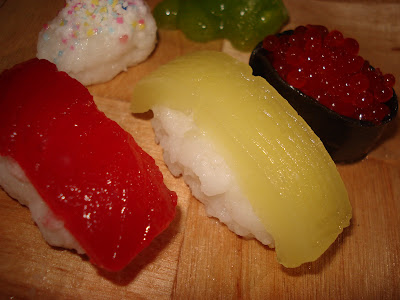
Looks pretty good? The red tuna was a bit watery, but pretty good flavor. The tamago was had a good consistency, and tasted pretty good. The Ikura (considering) was excellent! Some of the roe were small, but good outer texture, popped like it's supposed to, and the juice inside was nice and sweet. Yes, SWEET. Can you believe it, it's "make-your-own candy"

I'm going to have to make better documentation when I get another box of it. Didn't get around to recording the process since I was making it in the middle of a house party. However, there is more to this series. "The Cake Store"
...
So I initially thought I'd work on the cake store, take hot pics, and say how great it was... well, not so much. I enjoyed making the cakes, but the intricacy was nowhere near the caliber of the sushi kit so it was a bit disappointing. Then I ate one of the cakes that didn't come out right for the photo op. Never again. Sushi kit all the way!!! still, check out how cute these things came out. Do it for the creation aspect, just don't put it in your mouth ;)
























